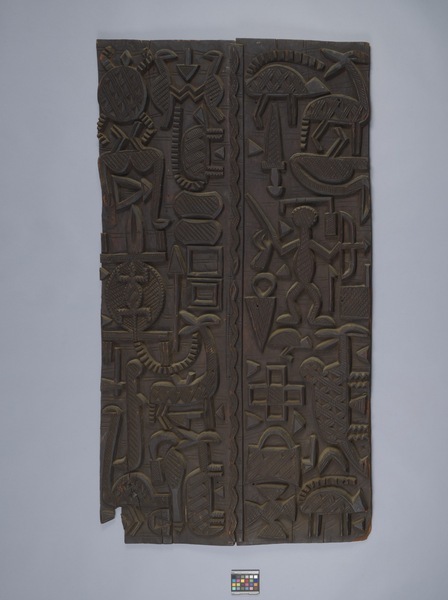Door Item Number: 3326/27 from the MOA: University of British Columbia

Description
Door made of two darkened, rectangular wooden panels with a thin rectangular piece of wooden trim covering where the panels join. Trim attached to the right panel by ten nails. Eight nail holes on right edge of left panel, likely where the trim was attached to left panel. Two snakes carved in high relief, moving towards one another, on the wooden trim. On the two panels there are high relief carvings of plants, tools, weapons, geometric shapes, humans, birds, lizards, crocodiles, turtles, and other quadrupeds. Background of panels has gouged cross-hatched lines throughout. Six holes, total, along the edges of both panels. Three on right edge of right panel at the bottom, centre and top. Three on left edge of left panel at bottom, centre and top. Three smaller holes, in a triangular pattern, are on the left edge of the left panel between the larger middle and top holes. Backs of panels are undecorated. Hanging hardware secures the two panels together, on the back.
History Of Use
Sculpted by Sakiwa the Younger, the door incorporates images of hunters and animals, knives, bows and arrows, a flintlock rifle and quincunx designs.
Narrative
Jack Lieber said the door was purchased after negotiations with the carver, Sakiwa the Younger, then collected for him by a trader. Lieber was living in Nigeria, from 1965-1970, lecturing at the University of Ibadan, under the auspices of CIDA.
Item History
- Made by the Younger Sakiwa (Maker) in Lapai, Nigeria
- Collected between 1965 and 1970
- Owned by Jack Lieber before 2015
- Owned by Iris Lieber before June 18, 2018
- Received from Iris Lieber (Donor) on June 18, 2018
What
Who
- Culture
- Nupe
- Creator
- the Younger Sakiwa (Maker)
- Previous Owner
- Jack Lieber and Iris Lieber
- Received from
- Iris Lieber (Donor)
Where
- Holding Institution
- MOA: University of British Columbia
- Made in
- Lapai, Nigeria
When
- Collection Date
- between 1965 and 1970
- Ownership Date
- before 2015 and before June 18, 2018
- Acquisition Date
- on June 18, 2018
Other
- Condition
- poor
- Accession Number
- 3326/0027